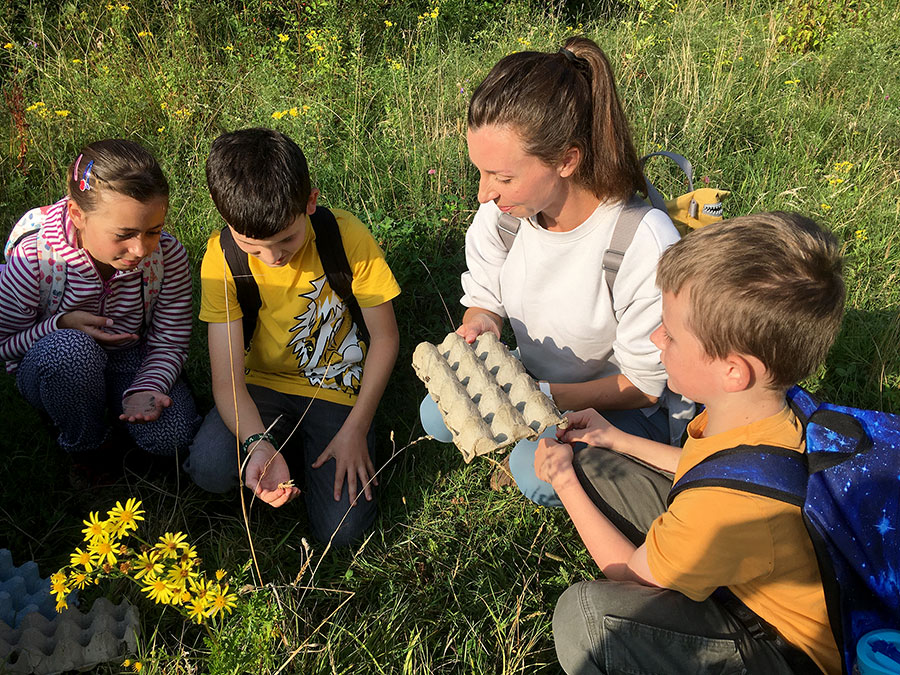
By Sara Messenger of Bradley Stoke’s Three Brooks Nature Conservation Group.
I had planned to wax lyrical about nature’s quilt of a thousand greens and of its subtle shift as she gently changes into her autumnal colours of red and brown, but as I stand yet again cold and dripping, peering through the torrential rain I can see no thousand greens, just a few grey blurs. Autumn’s approach has been far from subtle!
With all this rain we had hoped that the ‘new’ pond on Bowsland Meadow would finally fill up, but it was not to be and annoyingly it seems to remain one of the driest areas on the reserve. Gill and I took a spade and discovered 8 inches down a very, very thin layer of clay and some white cloth lining. The only phrase I can repeat here is “As useful as a chocolate teapot,” although many others were used. Whilst not wanting to throw good money after bad, I remain tempted for us to just buy a plastic pond liner and be done with it. No woman likes to be kept waiting and five years is far too long to wait for the pond to establish itself.
Community orchard
Before the rains came we were scything the community orchard and tending Colin’s allotment. Like the man himself, his allotment is colourful, productive, exuberant and just a tad untameable! This month, amongst the fruit bushes, we’ve added onions, beans, potatoes and crow garlic, so next year’s foragers won’t have far to walk before their baskets are overflowing! It’s not been a good year for apples but we still have some fruit to pick and along with the last of the blackberries there is just enough left for a crumble or two.
We have two apples trees that are of an unknown variety. Some of the fruit was picked, photographed, measured and finally tasted and next year we hope to be able to name them something other than A3931 and A3932. ‘Green-Gym Gage’ and ‘Bowsland Beauty’ are two of the suggestions so far, but I’m sure you can all come up with a few more. Next year there is a project to test old crab apple trees. We have a beauty close to the skate park but if you spot any others, not just on the reserve but anywhere in South Gloucestershire please note the location, take a picture and send it to us so that it can be included in the project.
Walks and talks
We have this month managed two bat walks, the first was for group members only. As it was the first time Andy Selman had led a public walk, we thought we should ‘test him out’ first. After all, if he can survive the group, he can survive anything. Even though we found very few bats, not even over the lake, which is usually a popular spot, we felt that had more to do with the recent pollution and less to do with Andy. I’m pleased to say he passed the test and on 30th September, the last day of bat survey season, he led a walk for us. On the day, only half of the ticket holders braved the weather, but in between the showers they were rewarded for their fortitude when they were able to hear and see some pipistrelles in Savages Wood. ‘Pips’ are the UK’s smallest bat with a wingspan of around 20cm and weigh no more than a pound coin.

We also managed a moth survey. We trapped the same field as before, although previously that was in early July and early August, so we were interested in having a comparison with early September. Three light traps were put out on the Friday night and on the Saturday morning moth expert Peter Cranswick led us through our finds – light emerald, angel shade, blood vein, Chinese character, cypress pug, common marbled carpet, willow beauty, peach blossom and brimstone to name but a few. Peter was just telling us that most moths were named by vicars, when a young voice piped up: “What’s this one called?” and he had to concede that maybe the ‘Playboy moth’, as it’s commonly known, was perhaps one not named by a vicar!

Our AGM may have been the quietest on record, but we are pleased to welcome back to the committee Gill Smith and to welcome first-timer Freya Smith (even if she does dramatically lower the average age!). We would like to say ‘thank you’ to Rachel and Andy M who after several years on the committee have stepped down; and thanks also to those that have stayed on. I think Freya’s first task should be to find the wood we have ‘lost’. According to the Manor Farm plaque, we have a Bowsland Wood, which was news to us. I know the reserve is large (6.5 million sq ft) but to lose an entire wood seems just a tad careless.
Water projects
Although the weather curtailed our last Saturday workday, we are hopeful that the future water projects, the desilting of the lake and BARTs in-river berm creation have better luck. Brushwood berms (or deflectors) are small bundles of wooded material that are staked into the side of the river, they act as a meander type of function, creating diversity in flow, capturing silt and sediment in the river and providing habitat for fish and invertebrates. Our first attempt at making these will be in Stoke Brook (between Braydon Avenue and the lake). I have suggested that as we have Trolletheus, our own deity, to watch over the waterways on the reserve, we should make them an offering before we start the project, although I have no idea yet as to quite what that would entail, but I am sure we will think of something.
How to contact the Three Brooks Nature Conservation Group:
- t: 07497 006676
- e: info@three-brooks.info
- w: www.three-brooks.info
- Facebook: Three Brooks Nature Conservation Group
This article originally appeared in the October 2021 issue of the Bradley Stoke Journal magazine (on pages 14 & 15). The magazine is delivered FREE, nine times a year, to ALL 8,700 homes in Bradley Stoke. Phone 01454 300 400 to enquire about advertising or leaflet insertion.





